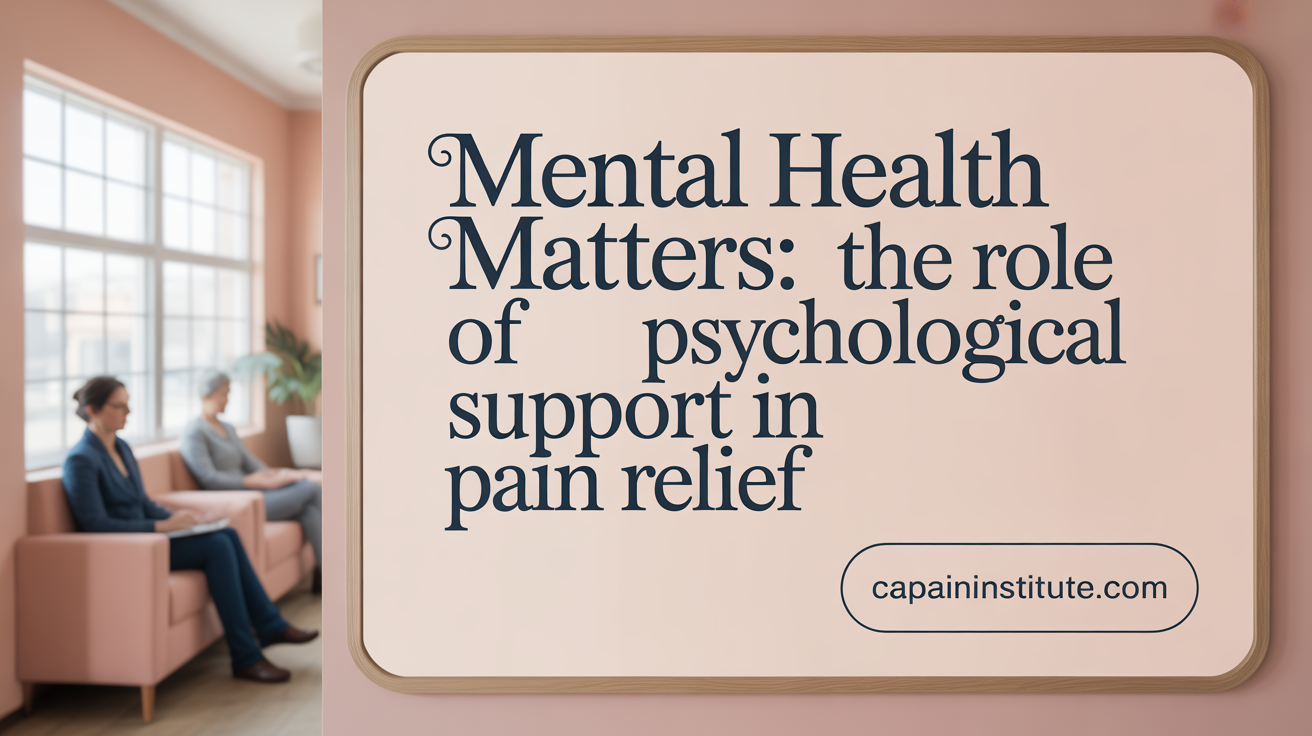Understanding the Multidisciplinary Approach to Chronic Pain
Chronic pain is a complex health challenge affecting millions worldwide, requiring more than just conventional treatments. Multidisciplinary pain management programs represent an innovative, integrative approach that addresses the multifaceted nature of pain by combining medical, psychological, and rehabilitative therapies. This article explores the numerous advantages and core components of these programs, their clinical effectiveness, and the holistic strategies they employ to improve patient outcomes and quality of life.
Foundations and Rationale Behind Multidisciplinary Pain Management

What are the underlying principles and rationale of multidisciplinary pain management?
Multidisciplinary pain management is rooted in the biopsychosocial model, which emphasizes that chronic pain is a complex condition influenced by a combination of physical, psychological, and social factors. This understanding encourages a holistic approach to treatment rather than focusing solely on physical symptoms.
A core element involves collaboration among a diverse team of healthcare professionals. These teams typically include physicians such as pain specialists and anesthesiologists, psychologists, physical and occupational therapists, nurses, social workers, and other specialists like chiropractors or pharmacists. They work together to develop and implement personalized treatment plans that address all aspects of a patient's pain experience.
The rationale behind this approach is that addressing multiple contributing factors at the same time results in more effective pain relief and better overall outcomes. Unlike treatments centered only on medication or surgery, multidisciplinary strategies incorporate medical interventions, physical therapy, psychological support, and holistic therapies like mindfulness, yoga, and nutrition.
Patient education and self-management are vital components of the rationale. Empowering patients with coping skills and knowledge helps them better control their pain and reduces dependency on opioids and other medications.
Research supports that these comprehensive programs not only provide superior pain relief but also improve mental health, functional ability, and quality of life. They are designed to promote long-term recovery by targeting the physical, emotional, and social dimensions of pain.
Overall, the principles of multidisciplinary pain management prioritize coordinated, patient-centered care that treats the whole person, leading to more sustainable and meaningful improvements in living with chronic pain.
Key Components and Structure of Multidisciplinary Pain Management Programs

What are the components and structure of multidisciplinary pain management programs?
Multidisciplinary pain management programs bring together a diverse team of healthcare professionals dedicated to providing comprehensive, patient-centered care. The team typically includes physicians such as pain specialists and anesthesiologists, physical and occupational therapists, psychologists, nurses, dietitians, social workers, and sometimes complementary therapists like acupuncturists. Each member offers expertise to address different facets of chronic pain.
The program's structure involves several coordinated steps. Initially, patients undergo thorough assessments that evaluate physical, psychological, social, and occupational factors contributing to their pain. These evaluations guide the development of individualized treatment plans, designed to target all relevant aspects of the patient's condition.
Regular team meetings and coordinated communication are essential to ensure seamless integration of care. Healthcare providers share progress, reassess patient needs, and modify treatment strategies accordingly.
Core treatments within these programs include medical therapies like medications or interventional procedures, psychological interventions such as cognitive-behavioral therapy (CBT), physical therapies like exercises and manual therapy, and educational components that promote self-management.
The goal is to combine these modalities into a cohesive treatment plan that addresses not only pain relief but also aims to improve functional ability, mental health, and overall quality of life. Programs typically last between 8 to 12 weeks, with ongoing evaluations to optimize outcomes.
Effective multidisciplinary programs demonstrate significant reductions in pain intensity, enhanced psychological wellbeing, and increased physical functioning, ultimately fostering greater independence and improved daily living.
While the effectiveness of these programs is well-supported, considerations such as cost and resource allocation can influence their availability and implementation.
Clinical Effectiveness and Evidence Supporting Multidisciplinary Approaches

What evidence supports the clinical effectiveness of multidisciplinary approaches to pain management?
Research consistently demonstrates that multidisciplinary pain management significantly improves outcomes for patients suffering from chronic pain conditions. Studies show that these approaches lead to higher pain relief, better functional ability, and enhanced psychological well-being compared to treatments focusing on a single discipline.
Multidisciplinary programs involve a team of healthcare professionals, including physicians, psychologists, physical therapists, and social workers, working together to create personalized treatment plans. These plans often include medication management, physical therapy, cognitive-behavioral therapy (CBT), mindfulness, and complementary therapies like acupuncture. This comprehensive strategy addresses all aspects of pain — physical, psychological, and social — based on the biopsychosocial model.
Clinical trials highlight that early and tailored interventions result in better diagnoses and outcomes. Patients experience improved ability to perform daily activities, and satisfaction rates are higher due to collaborative care. For example, programs that integrate rehabilitation, psychological support, and lifestyle modifications lead to reductions in pain intensity and disability.
Further evidence supports the notion that multidisciplinary approaches are more effective in managing complex pain than single treatments or outpatient care alone. Overall, these strategies promote better adherence, faster recovery, and improved quality of life.
While cost-effectiveness remains a concern due to higher initial expenses, the long-term benefits — including reduced emergency visits, lower medication reliance, and fewer hospitalizations — support the value of these programs. Enhanced coordination and communication within teams foster individualized, holistic care, making multidisciplinary treatment a robust, evidence-based solution.
| Aspect | Impact | Supporting Evidence |
|---|---|---|
| Pain Relief | Significant improvement | Clinical trials show higher pain reduction scores |
| Functional Ability | Enhanced daily functioning | Studies demonstrate better mobility and activity levels |
| Psychological Well-Being | Reduced depression and anxiety | CBT and behavioral health interventions show measurable benefits |
| Patient Satisfaction | Increased satisfaction with care | Patients report improved overall quality of life |
| Cost-Effectiveness | Promising but variable | Evidence suggests long-term savings, though more research needed |
This comprehensive approach aligns with international pain management guidelines and continues to evolve with ongoing research, solidifying its role as a cornerstone in managing chronic pain effectively.
Holistic and Integrated Strategies: Addressing Pain from All Angles
 In multidisciplinary pain management, a variety of holistic and integrated strategies are employed to treat the complex nature of chronic pain. This approach combines medical, psychological, and lifestyle therapies, all tailored to meet the individual needs of each patient.
In multidisciplinary pain management, a variety of holistic and integrated strategies are employed to treat the complex nature of chronic pain. This approach combines medical, psychological, and lifestyle therapies, all tailored to meet the individual needs of each patient.
The foundation of these strategies lies in a coordinated effort among diverse healthcare professionals. Physicians, psychologists, physical therapists, occupational therapists, and complementary health practitioners collaborate closely to develop personalized care plans. This seamless communication and sharing of information are facilitated through shared medical records and regular team meetings, ensuring a comprehensive approach.
Medical treatments often include medication management, interventional procedures, and non-invasive options like acupuncture and neurostimulation. Alongside these, patients participate in physical therapies such as exercise and manual therapy, aimed at restoring function and reducing inflammation.
Psychological support plays a crucial role, with cognitive-behavioral therapy (CBT), mindfulness, meditation, and stress reduction techniques used to address emotional and mental health issues associated with chronic pain. These mind-body approaches help patients manage pain perception, emotional distress, and improve overall well-being.
Lifestyle modifications constitute an important part of the strategy. Nutritional counseling, sleep hygiene education, and activity pacing are incorporated to enhance recovery and promote healthful habits. Self-management education empowers patients, teaching skills like pacing and resilience-building, which support long-term pain control.
Complementary therapies such as massage, yoga, herbal medicine, and relaxation techniques are integrated to offer additional relief and address physical and mental aspects of pain. These therapies are often used in conjunction with conventional treatments, creating a layered, person-centered treatment plan.
Effective multidisciplinary programs also promote patient involvement through education about pain mechanisms, coping strategies, and the importance of ongoing self-care. This empowerment allows individuals to take an active role in their recovery, improve their quality of life, and decrease reliance on medications.
Overall, the success of these strategies hinges on team collaboration, comprehensive assessment, and a focus on the person as a whole. By embracing an integrated, multidisciplinary care model, clinicians can more effectively address the interconnected physical, emotional, and social factors contributing to chronic pain, leading to more sustainable and meaningful improvements for patients.
Psychological Support and Mental Health: Pillars of Effective Pain Management

What is the role of psychological support and mental health integration in multidisciplinary pain management programs?
Psychological support and mental health are fundamental elements within multidisciplinary pain management that significantly improve patient outcomes. These programs typically incorporate mental health interventions such as cognitive-behavioral therapy (CBT), acceptance and commitment therapy (ACT), and mindfulness-based strategies to address the emotional, cognitive, and behavioral facets of chronic pain.
Including mental health professionals—such as psychologists, psychiatrists, or integrated-care providers—enables accurate diagnosis and treatment of common psychiatric comorbidities like depression, anxiety, and post-traumatic stress disorder (PTSD). These conditions often exacerbate pain perception and hinder recovery. By tackling these issues directly, mental health support helps reduce emotional distress, maladaptive thoughts, and pain catastrophizing, fostering a more positive outlook and resilience.
Tools like the PHQ-9 for depression and the GAD-7 for anxiety allow clinicians to repeatedly assess emotional well-being, monitor progress, and tailor treatments effectively. This ongoing evaluation ensures the personalized adjustment of therapies, improving adherence and engagement.
This integration not only enhances pain relief but also promotes better overall functioning by addressing the psychological impacts of chronic pain. The biopsychosocial model underpinning these programs emphasizes that mental health care complements physical treatments, creating a holistic approach to pain management.
Ultimately, fostering mental well-being through these interventions leads to increased self-efficacy, improved mood, and a higher quality of life. By combining psychological support with physical therapies, multidisciplinary programs offer a comprehensive strategy that targets all dimensions of the chronic pain experience.
Comparing Multidisciplinary Programs with Other Pain Treatments

How do multidisciplinary programs differ from other treatments for chronic pain?
Multidisciplinary pain programs involve a coordinated effort among healthcare providers from multiple specialties, such as physicians, psychologists, physiotherapists, occupational therapists, nurses, and social workers. This team-based approach conducts comprehensive assessments to develop personalized treatment plans that address biological, psychological, and social factors contributing to chronic pain.
Unlike single-discipline treatments — which might focus solely on medication, physical therapy, or psychological counseling — multidisciplinary programs integrate various therapies within a single plan. This may include medications, physical rehabilitation, psychological interventions like Cognitive Behavioral Therapy (CBT), acupuncture, mindfulness, and patient education.
The goal is not just pain relief but improving overall function, mental health, and quality of life. These programs emphasize collaborative goal-setting, regular team meetings, and shared patient data to ensure holistic care.
Evidence supports that this integrated approach can reduce pain severity, enhance activity levels, reduce medication reliance (particularly opioids), and decrease healthcare utilization, such as emergency visits. While the evidence base continues to grow, the heterogeneity among studies suggests variability in outcomes. Nevertheless, multidisciplinary care consistently outperforms treatments offered by individual disciplines alone.
In contrast, standard treatments often focus on isolated interventions, which may temporarily reduce pain but fail to address the complex and multifaceted nature of chronic pain conditions. Overall, multidisciplinary programs offer a comprehensive, personalized, and often more effective approach to managing persistent pain.
Overall Impact: Enhancing Life Quality and Healthcare Outcomes

What is the overall impact of multidisciplinary programs on managing chronic pain effectively?
Multidisciplinary pain management programs significantly improve how chronic pain is treated by offering comprehensive, patient-centered care that tackles the physical, emotional, and social components of pain.
These programs bring together various healthcare providers, such as physicians, psychologists, physiotherapists, occupational therapists, nurses, and social workers, to work collaboratively. This teamwork results in more accurate diagnoses and tailored treatments that are suited to each patient's unique needs.
Patients often experience notable reductions in pain severity and improvements in their ability to perform daily activities. For instance, research indicates that such programs can lower pain intensity and enhance quality of life, including decreased depression and better physical functioning.
Importantly, multidisciplinary approaches have shown to reduce reliance on opioids by over 20%, contributing to efforts aimed at controlling the opioid epidemic. This shift to multimodal pain management also minimizes medication side effects and risks.
From an economic perspective, evidence, such as the Geisinger program, demonstrates that these comprehensive treatments can lead to healthcare cost savings. These savings primarily come from fewer unnecessary hospital visits, reduced use of high-cost diagnostics, and faster recovery times.
Operationally, multidisciplinary programs optimize healthcare resource utilization by decreasing emergency visits and expensive interventions, thus enhancing overall system efficiency.
Patients also benefit from increased empowerment and self-management skills through education and coping strategies, which foster long-term pain control. Self-management techniques like pacing and desensitization teach patients how to actively participate in their pain management, promoting independence.
Overall, these programs create a virtuous cycle of improved clinical outcomes, better quality of life, and more sustainable healthcare practices. They mark a meaningful advancement over traditional, single-discipline treatments, emphasizing holistic care that addresses the complex nature of chronic pain.
Such integrated models of care are endorsed by major health organizations and are increasingly recognized as the standard approach for complex pain conditions. As ongoing research continues to support their effectiveness, multidisciplinary programs are poised to reshape chronic pain management globally.
Embracing Integrated Pain Care for Lasting Relief
Multidisciplinary pain management programs represent a paradigm shift in chronic pain treatment by addressing the condition's complex, multidimensional nature through comprehensive, coordinated care. Their holistic and evidence-based strategies not only alleviate pain but also enhance patients' physical function, mental health, and overall quality of life. Despite challenges such as cost and implementation barriers, the benefits—demonstrated by improved outcomes, reduced opioid reliance, and patient empowerment—underscore the value of this approach. As research continues and accessibility improves, multidisciplinary programs stand poised to become the cornerstone of effective, patient-centered chronic pain management.
References
- Benefits of a Multidisciplinary Approach to Pain Management
- Multidisciplinary Treatment Programs for Patients with Chronic Non ...
- Multidisciplinary pain management program (MPP) - Geisinger
- The Multidisciplinary Team in Pain Management - PubMed
- Multidisciplinary Pain Management Team: 7 Powerful Benefits 2025
- How Multidisciplinary Care Benefits Chronic Pain Patients
- A multidisciplinary pain management program for patients with ...
